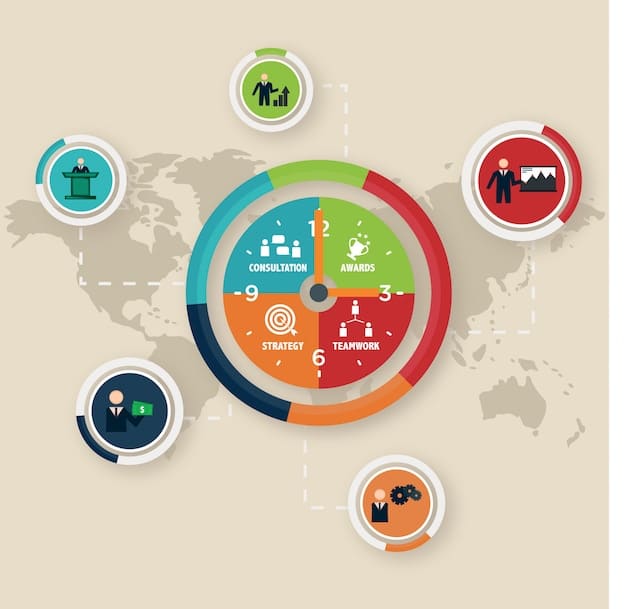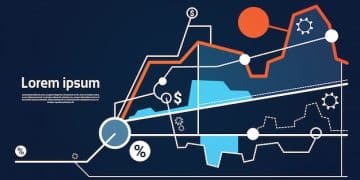Risk Management Strategies: Identify & Mitigate Business Threats

Risk management strategies are crucial frameworks businesses implement to proactively identify, assess, and mitigate potential threats, ensuring operational resilience and safeguarding future growth.
In today’s dynamic business landscape, organizations face an ever-evolving array of uncertainties. From economic downturns and technological disruptions to cybersecurity breaches and regulatory shifts, the potential for unforeseen challenges to derail even the most robust operations is a constant reality. Effectively navigating this complexity requires more than just reactive measures; it demands a proactive and systematic approach to safeguard your ventures. This is where robust risk management strategies: identifying and mitigating potential threats to your business, become not merely an administrative task, but a cornerstone of sustainable success. Embracing a comprehensive risk framework allows businesses to anticipate pitfalls, allocate resources wisely, and ultimately turn potential vulnerabilities into opportunities for strategic advantage.
understanding business risk: a foundational perspective
Understanding business risk is the bedrock upon which all effective risk management strategies are built. It’s not simply about identifying what could go wrong, but grasping the nature of uncertainty itself and how it intersects with an organization’s objectives. Risks, in essence, are any uncertainties that could affect an organization’s ability to achieve its strategic, operational, reporting, or compliance objectives. These uncertainties can stem from a myriad of sources, both internal and external, each demanding tailored consideration.
The complexity of modern global economies means that businesses are increasingly interconnected, magnifying the ripple effects of localized issues. A geopolitical event in one region, for instance, can disrupt supply chains globally, impacting production schedules and delivery times for companies thousands of miles away. Similarly, a seemingly minor technological glitch can escalate into a major data breach, compromising sensitive customer information and eroding public trust.
identifying the spectrum of risks
Effective risk identification involves a systematic process of brainstorming, data analysis, and expert consultation. It requires looking beyond the obvious and delving into the less apparent vulnerabilities that could impact operations. Categorizing these risks helps in structuring the subsequent analysis and mitigation efforts. Common categories include strategic, operational, financial, compliance, and reputational risks.
- Strategic Risks: Relate to an organization’s business model, competitive landscape, and long-term objectives.
- Operational Risks: Associated with the day-to-day operations, including processes, systems, people, and external events.
- Financial Risks: Involve a company’s financial health, such as market fluctuations, credit risks, and liquidity issues.
- Compliance Risks: Stem from the failure to adhere to laws, regulations, internal policies, and ethical standards.
Reputational risk, while often difficult to quantify directly, can have devastating long-term effects. A tarnished brand image, resulting from ethical lapses or product failures, can lead to customer defection, employee morale issues, and investor reluctance. The pervasive nature of social media further amplifies these risks, as negative news can spread globally within minutes, often before organizations have a chance to formulate a coherent response.
Ultimately, a deep understanding of business risk is not about fear, but about fostering an organizational culture of preparedness. It equips leaders with the insight needed to make informed decisions, allocate resources effectively, and build resilience into their core operations. This foundational knowledge allows businesses to move from a reactive posture to a proactive and strategic one, capable of weathering storms and seizing emerging opportunities.
the process of risk identification and assessment
Once the foundational understanding of business risk is firmly established, the practical application begins with a rigorous process of risk identification and assessment. This stage is arguably the most critical, as failure to accurately identify and evaluate potential threats can render subsequent mitigation efforts ineffective. It’s a continuous, iterative cycle, not a one-time event, reflecting the dynamic nature of business environments.
The initial step involves casting a wide net to capture all conceivable risks. This often begins with workshops and brainstorming sessions involving diverse stakeholders from various departments. Employees on the front lines often have unique insights into operational vulnerabilities, while senior management brings a strategic perspective. External consultants can also provide an unbiased, expert view, identifying blind spots that internal teams might overlook.
quantitative vs. qualitative risk analysis
Risk assessment typically employs both qualitative and quantitative methods to evaluate identified threats. Qualitative analysis prioritizes risks based on their potential impact and likelihood, often using a descriptive scale (e.g., “high, medium, low”). This method is particularly useful in the early stages when detailed data might be scarce, providing a quick snapshot of the most pressing concerns.
- Qualitative Analysis: Involves subjective judgment and expert opinion to prioritize risks without specific numerical values.
- Quantitative Analysis: Utilizes numerical data and statistical models to assign values to the probability and financial impact of risks.
Quantitative analysis, conversely, delves deeper, assigning numerical values to the probability of a risk occurring and the potential financial or operational impact if it does. Techniques such as Monte Carlo simulations, sensitivity analysis, and decision tree analysis are employed to model various scenarios and quantify potential losses. While more data-intensive, quantitative analysis provides a clearer business case for investing in specific mitigation strategies, allowing for a cost-benefit analysis of different approaches.

A crucial element of this process is the development of a risk register, a centralized document that catalogs all identified risks, their characteristics, assessment scores, and assigned ownership. This register serves as a living document, constantly updated as new risks emerge or existing ones evolve. Regular reviews of the risk register ensure that the organization maintains an up-to-date awareness of its risk profile.
The ultimate goal of risk identification and assessment is to create a clear, comprehensive picture of the organization’s vulnerabilities. This picture then informs the development of targeted and effective mitigation strategies, ensuring that resources are allocated to address the most significant threats with the highest potential impact. Without this meticulous groundwork, any subsequent risk management efforts are likely to be misdirected and fall short of their intended purpose.
developing robust risk mitigation strategies
Having comprehensively identified and assessed potential threats, the next critical phase in the risk management journey is the development and implementation of robust risk mitigation strategies. This involves crafting specific action plans designed to reduce the likelihood of a risk occurring, lessen its impact if it does materialize, or, in some cases, accept the risk after careful consideration. Effective mitigation is not a one-size-fits-all solution; it requires a tailored approach based on the nature, severity, and context of each specific risk.
The choice of mitigation strategy hinges on the findings from the risk assessment. For high-impact, high-likelihood risks, aggressive mitigation is typically warranted. For lower-impact or lower-likelihood risks, a more measured response, or even acceptance, might be appropriate. The four primary strategies for risk mitigation are:
avoidance, reduction, transfer, and acceptance
- Risk Avoidance: This strategy involves eliminating the risk entirely by choosing not to engage in the activity that gives rise to it. For example, a company might decide not to enter a volatile market to avoid geopolitical or economic risks. While ideal, avoidance is often impractical as it can mean foregoing potential opportunities.
- Risk Reduction (or Mitigation): The most common strategy, focusing on lowering the probability or impact of a risk. This includes implementing controls, improving processes, training staff, or investing in new technologies. Examples include robust cybersecurity measures to prevent data breaches, rigorous quality control to minimize product defects, or clear emergency protocols to handle operational disruptions.
- Risk Transfer: Shifting the financial burden or responsibility of a risk to a third party. Insurance is the most common form of risk transfer, where an insurer assumes the financial risk of specific events in exchange for premiums. Outsourcing certain functions (e.g., IT, logistics) can also transfer some operational risks to specialized providers.
- Risk Acceptance: Acknowledging that a risk exists and deciding to take no action to mitigate it, often because the cost of mitigation outweighs the potential impact of the risk. This strategy is typically reserved for low-impact, low-probability risks, or where the remaining risk is minimal after other strategies have been applied. It’s crucial that acceptance is a conscious decision, not merely an oversight.
Implementing these strategies requires careful planning and allocation of resources. It also necessitates cross-functional collaboration, as mitigation efforts often span multiple departments. For instance, reducing cybersecurity risk involves not just the IT department, but also employee training, policy development by HR, and oversight from legal. Regular monitoring of the effectiveness of implemented controls is also vital. What worked yesterday might not be sufficient tomorrow, especially in rapidly evolving risk environments.
Ultimately, developing robust risk mitigation strategies transforms abstract risk assessments into concrete, actionable steps. It empowers organizations to move from identifying threats to actively building resilience, minimizing potential losses, and protecting their valuable assets and reputation. This proactive approach ensures that businesses are not simply reacting to crises, but are strategically positioned to navigate them successfully.
implementing and monitoring risk management frameworks
The true value of any risk management strategy lies in its effective implementation and continuous monitoring. A meticulously crafted strategy remains theoretical if it’s not seamlessly integrated into the organization’s daily operations and continuously refined. This phase often presents the greatest challenge, requiring not only technical expertise but also strong leadership, clear communication, and a culture that embraces risk awareness.
Implementation begins with clearly communicating the chosen mitigation strategies across all relevant levels of the organization. Employees need to understand their roles and responsibilities in the risk management framework. This involves training programs, clear policy documents, and accessible guidelines that articulate expectations and procedures. For instance, if a new cybersecurity protocol is implemented, every employee must be aware of their responsibilities regarding password hygiene and phishing awareness.
integrating risk into daily operations
For risk management to be truly effective, it must become an intrinsic part of how the business operates, rather than a separate, siloed function. This means embedding risk considerations into strategic planning, decision-making processes, project management, and daily operational procedures. For example, when evaluating a new market entry, the potential geopolitical, economic, and regulatory risks should be as central to the discussion as market opportunity and financial projections.
- Regular Reviews: Schedule periodic reviews of the risk register and mitigation plans. Quarterly or bi-annual reviews help ensure relevance.
- Performance Indicators: Establish key risk indicators (KRIs) to monitor the effectiveness of controls and identify emerging risks.
- Accountability: Assign clear ownership for each risk and its corresponding mitigation actions to specific individuals or departments.
Monitoring is the vigilant eye that ensures the risk management framework remains effective and responsive. This involves tracking key risk indicators (KRIs), which are metrics that provide an early warning of increasing risk exposure. For example, an increasing number of failed login attempts could be a KRI for a potential cyberattack, while declining customer satisfaction scores could signal a growing reputational risk.
Technology plays an increasingly vital role in streamlining implementation and monitoring. Risk management information systems (RMIS) can automate risk reporting, track mitigation plan progress, and provide real-time dashboards for management. These tools enhance efficiency, improve data accuracy, and allow for quicker response times to emerging threats. However, technology is only an enabler; the human element of oversight, judgment, and responsiveness remains paramount.
The cyclical nature of risk management requires constant adaptation. As business environments change, new risks emerge, and old ones evolve. Therefore, the implementation and monitoring phase is not a destination but a continuous journey of refinement and improvement, ensuring that the organization’s defenses against potential threats remain robust and relevant.
the role of technology in risk management
In the contemporary business world, technology has transformed from a mere enabler to an indispensable core component of effective risk management strategies. The sheer volume, velocity, and variety of data involved in identifying, assessing, and mitigating risks far exceed human capabilities for manual processing. Advanced technologies now provide the tools necessary to gain deeper insights, automate processes, and enhance the responsiveness of risk management frameworks.
One of the most significant contributions of technology is in data collection and analysis. Big data analytics platforms can process vast datasets from internal operations, market trends, social media, and cybersecurity feeds. This allows organizations to identify patterns, correlations, and anomalies that might indicate emerging risks long before they become critical. For instance, predictive analytics can forecast supply chain disruptions based on weather patterns, geopolitical tensions, or economic indicators.
automation and artificial intelligence
Automation, powered by artificial intelligence (AI) and machine learning (ML), is revolutionizing various aspects of risk management. AI algorithms can scour through regulatory changes, identify compliance risks, and even flag potential fraud patterns in financial transactions. In cybersecurity, AI-driven systems can detect and respond to threats in real-time, significantly reducing the impact of attacks by immediately isolating compromised systems.
- Predictive Analytics: Utilizing historical data to foresee future risk events and their potential impact.
- Real-time Monitoring: Continuous scanning of systems and environments for anomalies and immediate threat detection.
- Compliance Automation: AI solutions streamline regulatory updates and policy adherence checks, reducing human error.
Risk Management Information Systems (RMIS) serve as centralized hubs for all risk-related data. These platforms integrate information from various departments, providing a holistic view of the organization’s risk profile. Features like interactive dashboards, automated reporting, and workflow management streamline the entire risk management process, from initial identification to ongoing monitoring and mitigation.
Furthermore, cloud computing offers scalable infrastructure for hosting complex risk models and enabling collaborative risk assessment across geographically dispersed teams. Blockchain technology, while still nascent in widespread risk management application, holds promise for enhancing transparency and immutability in supply chains and financial transactions, thereby reducing certain types of fraud and operational risks.
However, reliance on technology also introduces new risks, particularly in terms of data privacy, algorithmic bias, and system vulnerabilities. Therefore, the implementation of technology in risk management must itself be accompanied by robust governance and oversight, ensuring that the very tools meant to protect the business do not inadvertently expose it to new threats. When utilized strategically and responsibly, technology becomes a powerful ally in building intelligent, adaptive, and resilient risk management capabilities.
building a risk-aware organizational culture
While frameworks, processes, and technology are crucial components of effective risk management, the ultimate success of any strategy hinges on the human element – specifically, the cultivation of a risk-aware organizational culture. Without a shared understanding and commitment to managing risks, even the most sophisticated systems can falter. A strong risk culture embeds risk considerations into the DNA of the organization, making it an intuitive part of every decision and action.
Building such a culture starts from the top. Leadership must champion the importance of risk management, demonstrate commitment through their actions, and allocate necessary resources. When senior management publicly prioritizes risk awareness, it sends a clear message throughout the organization, encouraging employees at all levels to embrace their roles in mitigating potential threats.
fostering communication and accountability
Open and transparent communication is vital. Employees should feel comfortable identifying and reporting risks without fear of reprisal. This requires establishing clear channels for reporting, coupled with a commitment from management to listen and respond constructively. Workshops, training sessions, and internal communication campaigns can help demystify risk concepts and demonstrate their relevance to daily job functions.
- Leadership Commitment: Senior executives must visibly champion risk management and integrate it into strategic goals.
- Employee Training: Provide regular training on specific risks, reporting mechanisms, and mitigation protocols relevant to their roles.
- Incentivization: Consider incorporating risk management performance into employee evaluations and incentives.
Accountability is another cornerstone. Everyone, from the CEO to the newest intern, has a role to play in managing risk. Defining clear roles and responsibilities, and ensuring that individuals are held accountable for their actions (or inactions) related to risk, reinforces the importance of the framework. This doesn’t mean punishing mistakes, but rather fostering a learning environment where incidents are analyzed to prevent future recurrences.
A risk-aware culture also encourages proactive thinking. Instead of simply reacting to problems after they occur, employees are encouraged to anticipate potential issues, identify emerging threats, and recommend preventative measures. This forward-looking mindset allows the organization to be agile and adaptable, responding to changes in the internal or external environment with greater speed and effectiveness.
In essence, a strong risk culture transforms risk management from a compliance exercise into a strategic advantage. It creates an environment where prudent risk-taking is encouraged, informed by a deep understanding of potential downsides, and where everyone in the organization plays an active part in safeguarding its future. This collective vigilance is arguably the most powerful defense a business can possess against the uncertainties of the modern world.
case studies: lessons from effective risk management
Observing real-world applications of risk management strategies provides invaluable insights into both successes and failures. While theoretical frameworks are essential, examining how organizations have navigated complex challenges offers practical lessons that can be applied across various industries. These case studies highlight the importance of adaptability, foresight, and a comprehensive approach to managing potential threats.
Consider the response of a global tech company to a major supply chain disruption caused by an unforeseen natural disaster. Their existing risk management framework included robust contingency planning, identifying alternative suppliers, pre-negotiating emergency contracts, and diversifying manufacturing locations. When the disaster struck, they were able to pivot swiftly, rerouting production and sourcing from unaffected regions, thereby minimizing downtime and maintaining market supply. This proactive approach, cultivated through years of risk assessment and planning, allowed them to emerge from the crisis with minimal long-term impact on their operations and reputation.
navigating complex challenges
Another compelling example comes from the financial sector. A large bank, recognizing the increasing threat of cyberattacks, invested heavily in a multi-layered cybersecurity strategy. This included advanced threat detection systems, regular penetration testing, mandatory employee training on phishing and data hygiene, and a dedicated incident response team. While they experienced multiple attempts at breaches, their comprehensive strategy and rapid response capabilities consistently prevented significant data loss or financial system compromise. This proactive defense not only protected their assets but also reinforced customer trust and investor confidence.
- Proactive Planning: Organizations that anticipate and plan for potential disruptions fare significantly better in crises.
- Integrated Approach: Successful risk management considers interdependencies between different risk types (e.g., operational and reputational).
- Continuous Learning: Post-incident analysis and regular framework reviews are crucial for ongoing improvement and adaptation.
Conversely, lessons can also be drawn from situations where risk management was inadequate. The failure of some organizations to anticipate and adapt to rapid technological shifts, for instance, led to significant market share loss and, in some cases, outright failure. These instances underscore the importance of continuous environmental scanning, vigilance against emerging trends, and the willingness to pivot strategic direction even when comfortable with existing models.
Effective risk management isn’t about avoiding all risks but rather about making informed decisions about which risks to take, and how to prepare for and mitigate those that could pose a significant threat. These case studies reinforce the idea that risk management is not a static process, but a dynamic, evolving discipline that requires constant attention, adaptation, and a deep organizational commitment to resilience and strategic foresight.

| Key Point | Brief Description |
|---|---|
| 🔍 Risk Identification & Assessment | Systematic process of discovering and evaluating potential threats by likelihood and impact. |
| 🛡️ Mitigation Strategies | Actions taken to avoid, reduce, transfer, or accept risks based on their assessed severity. |
| 📊 Technology’s Role | Leveraging big data, AI, and RMIS for enhanced predictive analysis and real-time monitoring. |
| 🤝 Risk-Aware Culture | Fostering an organizational mindset where all employees contribute to risk management. |
frequently asked questions about risk management
▼
The primary purpose is to identify, assess, and mitigate potential threats that could adversely affect a business’s objectives, assets, or operations. This proactive approach aims to minimize losses, ensure business continuity, and support strategic decision-making by protecting the organization from unforeseen challenges.
▼
Risk management strategies should be reviewed regularly, ideally quarterly or bi-annually, and whenever there are significant internal or external changes. These changes could include new projects, market shifts, technological advancements, or regulatory updates, as risks are constantly evolving and require continuous adaptation.
▼
Businesses typically face strategic, operational, financial, compliance, and reputational risks. Strategic risks impact long-term goals, operational risks relate to daily functions, financial risks involve monetary stability, compliance risks pertain to regulations, and reputational risks concern public perception and brand image.
▼
No, it’s impossible for a business to eliminate all risks. The goal of risk management is not eradication but rather to identify, assess, and manage risks to an acceptable level. Some risks can be avoided or reduced, while others are accepted or transferred, depending on their nature and cost-benefit analysis.
▼
A strong risk-aware culture ensures that all employees understand and contribute to risk management, making it an integral part of daily operations. This fosters proactive identification, open communication, and accountability, ultimately enhancing the organization’s resilience and ability to navigate uncertainties effectively.
conclusion
In a world characterized by relentless change and unpredictable challenges, the importance of robust risk management strategies cannot be overstated. From the initial identification and meticulous assessment of potential threats to the development of tailored mitigation plans, their effective implementation, and continuous monitoring, every stage is vital for securing an organization’s future. The integration of advanced technology, coupled with the cultivation of a deeply ingrained, risk-aware culture, empowers businesses not just to survive crises, but to emerge stronger and more adaptable. By prioritizing proactive risk management, companies transform potential vulnerabilities into strategic advantages, safeguarding their assets, reputation, and ultimately, ensuring sustained growth in an increasingly complex global landscape.





